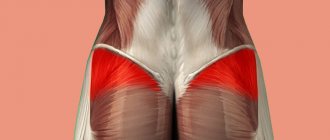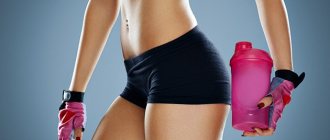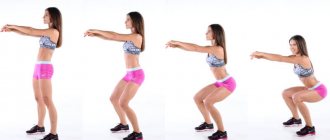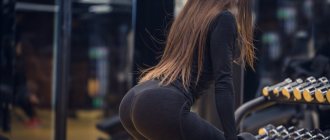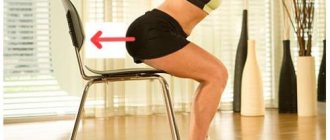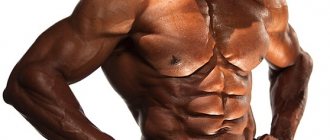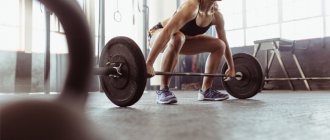May 17, 2011
With untrained buttocks, fat accumulates on them, and the load on the higher back muscles increases.
The buttocks are one of the most problematic areas of the body from an aesthetic point of view. Many people do not pay attention to the shape of their buttocks, and in vain. In the absence of training, they not only accumulate fat, but also increase the load on the higher back muscles. Marina Makarova, head of the exercise therapy department of the Center for Restorative Medicine and Rehabilitation of the Treatment and Rehabilitation Center of the Ministry of Health and Social Development of Russia, talks about how to strengthen the muscles of the buttocks and give them a beautiful shape.
How to make your butt big and pumped up
It is known that there is such an irresistible thing as hereditary predisposition. If a woman has a narrow pelvis, then training will not make it wider. And vice versa, if a man’s pelvis is wider than he would like, not a single gym will be able to narrow it. The shape of the butt depends mainly on the parameters of the gluteus maximus muscle, quite a bit - on the middle muscle, and practically does not depend on the gluteus minimus muscle. By the way, the length and width of the muscle cannot be changed either - genetics does not allow it. But you can pump up your butt and remove excess fat. That is, to a certain extent, increase muscle mass and “dry out” excess deposits. But everything is good in moderation: one admires elasticity, not thinness; Flabbiness is what disgusts, not fullness.
It is impossible to get an attractively shaped butt, although you can inherit it, but it won’t last long. The most reliable way is training. Moreover, to get a beautiful butt, experts advise pumping the upper, lower and lateral sectors of the buttocks separately. This allows you to form the surface with great precision, hide imperfections and bring the shape closer to the ideal. Next, we will look in detail at how to change specific areas of the buttocks.
Reason 5. Poor sleep
The importance of sleep is often underestimated, but insomnia and other disorders worsen mood, reduce performance, and make the day joyless. I want to drop everything, hide in a dark corner and sleep. There is no strength or desire left for training. Muscle recovery worsens, up to a complete lack of progress.
Exit: sleep at least 8 hours. If you get up at six in the morning, then in the evening you need to go to bed at ten, no later. Sleeping until noon on a day off does not mean quality rest, after which you can feel completely exhausted. It is advisable to stick to your usual rise, shifting it on weekends by no more than 2 hours.
© Tatyana — stock.adobe.com
How to pump up your upper buttocks
To obtain tangible results, discipline, adherence to a training regimen, and honest work with full dedication are of great importance. All this is achieved through motivation. It is recommended to conduct training three times a week, each session for about an hour. All the exercises below are performed in three sets, the number of repetitions should be gradually increased from 20 to 30 times.
Full squats with dumbbells are one of the best ways to pump up the upper buttocks, because the additional weight significantly improves the result.
So, holding dumbbells in your hands, stand straight with your feet 10 inches apart. Squat down gently, taking a deep breath, until the dumbbells touch the floor. The body should be slightly tilted forward, the back straight, the heel does not come off the floor. Without fixing yourself at the bottom point, rise vigorously, exhaling powerfully, and immediately begin squatting again.
| Recommended weight of dumbbells, kg | women | men |
| for beginners | 4–5 | 6–8 |
| further increase to | 10–15 | 16–32 |
The gluteal bridge is perfect for pumping up the upper part of the butt, and also develops the muscles of the back of the thighs and back extensors well.
Starting position - lying on your back, legs bent at the knees, place a barbell plate (or other additional weight) on your lower abdomen and hold it with your hands. As you exhale, lift your pelvis as high as you can, keep your back straight, resting on your shoulder blades and feet. Fix for a moment at the top, smoothly lower to the starting position, inhaling. Without pausing at the bottom point, immediately repeat the exercise.
Swing your leg back - in addition to pumping, it also stretches the gluteal muscles; the exercise strengthens and strengthens the muscles of the back of the thighs, promotes greater mobility of the hip joints.
Take an elastic band or expander and get on all fours, resting on your elbows and knees. Squeeze the ends of the elastic band in your hands, and secure the middle of the elastic band on the foot of your right foot. As you exhale, swing your right leg (without bending it) back and up, intensely straining your buttocks. Return your leg to the starting position while exhaling. After completing the required number of repetitions, strengthen the middle of the band on the foot of your left foot, and then repeat everything again.
Partial squat - this exercise helps to pump up the upper buttocks at home, although the skill itself can be useful in the office.
Place a chair behind you and begin to sit down, but touch the surface of it. The back should be straight, the buttocks tense, the distance to the chair should be minimal. When you reach the bottom, rise up. As soon as you find that you can maintain your balance without touching the chair, place a 3-5 cm thick stand under each sock. If you can squat stably without landing on the chair, then the preparatory part is complete. Then you can continue exercising without the safety net of a chair.
Reason 3. No BZHU balance
BJU is proteins (material), fats (give a feeling of fullness, help absorb vitamins, are needed for the synthesis of many hormones) and carbohydrates (builders). A lack of carbohydrates contributes to muscle wasting, so you should not eat only proteins, forgetting about everything else. To calculate the required amount of substances, you need to consume daily for each kg of body:
- 3-5 gr. carbohydrates (if you weigh 50 kg, you need to consume at least 150 grams of complex carbohydrates per day);
- 2 gr. protein (for 50 kg at least 100 grams per day);
- 1-1.5 gr. fat (per 50 kg - at least 50 grams per day).
Solution: to build up the gluteal muscles, you should maintain the above balance of BJU. Before training (1.5-2 hours) you should eat complex carbohydrates - buckwheat, rice, oatmeal, pasta, plus protein - chicken, meat, fish, cottage cheese, eggs. The same goes for after training. And a couple more of these techniques a day. As for fats, you should include nuts, flaxseed oil or fish oil in your diet.
© Alexander Raths — stock.adobe.com
What does a pumped up gluteus medius muscle provide, and what exercises are there for its growth?
It’s a shame to disappoint that part of the audience who, in an effort to figure out how to pump up the upper butt, hopes that there are separate muscles for the upper and lower buttocks. Alas, there are no separate muscles, as well as the ability to tense a separate section of a muscle fiber in such a way that another part of the same muscle remains relaxed. So how to pump up a big butt and a narrow waist? To do this, you need to increase the volume of all gluteal muscles and actively work on your posture, in particular, do not forget about stretching the lumbar region. In the context of correct posture, pumped gluteal muscles look more advantageous.
Loading the gluteus medius muscle is necessary in order to pump up the hollows of the buttocks, in other words, to pump up the side of the buttocks. This is achieved by performing the following exercises:
- walking on the buttocks - legs extended forward are positioned horizontally, back straight - vertically;
- swing your leg to the side from a lying position;
- gluteal bridge with fixation at the top point for 15–20 seconds;
- pulling your feet towards your buttocks while lying on your stomach.
But to get a big round butt, you need to use the gluteus minimus muscle. In many complexes it works together with other muscles of this group, and yet some exercises create a separate emphasis on the gluteus minimus muscle:
- moving the leg bent at the knee to the side from a standing position on all fours;
- abduction of the straight leg, held by the expander, to the side from a standing position;
- leg extensions in the simulator;
- plie squats with a dumbbell.
Everything has its price, including every action and inaction leads to predictable consequences. So, for example, if you work out hard in the gym (we recommend the sports club in Zyablikovo) and, having already achieved noticeable results, decide that this is enough, the same predicted consequences will occur. A subgluteal fold will appear. Moreover, the more advantageous the genetic predisposition to a beautiful butt shape and the more impressive the successes in enlarging the buttocks through training, the more clearly the annoying crease will stand out. The question of how to pump up the lower part of the butt now is not entirely correct. But, read on.
Leg forward lunges
Another way to pump up the lower part of the buttocks? An excellent solution is to regularly perform lunges with your feet forward. The workout stimulates the pumping of a variety of muscles in the lower body, especially strengthening the thighs. The exercise is performed according to this scheme. Take a straight body position while standing. The feet are placed at shoulder level. Take a big step in the frontal direction. The thigh should reach a position parallel to the floor. The foot of the hind leg is pulled back as far as possible and rested on the toe, the limb is straightened. The back is kept straight. Then they move to the starting position. Change position with emphasis on the other leg. The exercise is performed 10 times for each limb, 3 approaches.
How to tighten your lower buttocks
Muscles need tone, otherwise, when the load decreases, they become flabby and begin to sag. The reason for this may be not only the cessation of training that has already become habitual, but also the emergence of bad habits, a predominantly sedentary lifestyle, and a sharp change in weight.
How to tighten your butt from below? In short, by eliminating the causes of sagging soft tissues:
- remove excess fat;
- move more;
- leave bad habits;
- restore training.
These measures are usually sufficient. However, if you urgently need to tighten the bottom of your buttocks, then we recommend using strength exercises and specific walking:
- deep lunges with dumbbells - keep your back vertical;
- squats with dumbbells with legs wide apart;
- deadlift with dumbbells;
- walking uphill.
The last of the proposed exercises is best performed on a treadmill or on an ellipsoid, setting the inclination angle to at least 9–12%. The weight of dumbbells, the number of repetitions and approaches are indicated in the table at the beginning of the article. As you can see, making your butt big and pumped up is a doable task, and you can handle it.
Useful tips
To ensure that the shape of the buttocks and the level of tone of the local muscles do not cause any complaints, it is useful to follow these tips:
- Avoid going to the upper floors of buildings using elevators. Instead, choose to climb stairs on your own more often. The solution makes it possible to properly load the gluteal muscles and achieve the desired results, practically abandoning targeted training.
- Lead the most intense active lifestyle possible. After work, find time to participate in sports games. Sign up for swimming, running, dancing, cycling. Do exercises in the morning. All this together will strengthen the gluteal muscles.
- Try to eat healthy, excluding flour, fried, and sweet foods from your daily diet. From food, give preference to low-fat cottage cheese, milk and sour cream, as well as fresh vegetables and fruits. Replace fatty pork, smoked meats and all kinds of steaks with boiled chicken fillet. Drink more clean, high-quality water without gas. During the period of gluteal muscle training, completely stop drinking alcohol.
As for the actual organization of training, it is important to monitor your breathing during exercise. Under load, it is necessary to fill the lungs with air through the nose. It is advisable to exhale through the mouth while relaxing the body in the starting position. Movements should be smooth. If pain is observed, it is recommended to temporarily abandon the exercise that causes discomfort and, if possible, resort to other training options. To reduce the risk of such troubles, you should warm up and stretch beforehand.
Exercises to pump up the gluteal muscles should be organized systematically. Results can be seen when you spend at least 4 days a week training. The target set of exercises should be performed for half an hour. Loads should be increased as needed, when the initial exercises no longer require much effort.
Is exercise the key to health?
The lower back is the most vulnerable part of the entire human back. It experiences significant stress during any action - it doesn’t matter whether a person is sitting or walking somewhere. And what can we say about those moments when you have to endure some kind of hardship. Pregnant women experience particular stress on the lower back - it has to support the weight of not only most of the person’s body, but also the unborn child in the womb.
Load on the lower back when lifting weights
The lumbar spine consists of 5 large vertebrae . It is in this part of the back that the connection between the higher part of the spine - the thoracic region - and the sacrum occurs. In normal condition, the spinal column in the lumbar region has a slight bend, but given the fact that a person is now almost always in a sitting position (both at work and at home), this bend is often in the wrong position. Because of this, pain and discomfort often occur in the lumbar region.
Lumbar spine
It is also important to remember that the spine contains the bulk of the human nervous system, and the main support of the body is supplied with a large number of nerve endings. This area contains a large number of complex connective elements, flexible joints, and a complex circulatory system, all of which can be easily damaged. However, back pain can also occur due to weak muscle tone in this area.
Table. The main causes of back pain.
| Cause | Characteristic |
| Low physical activity | In modern conditions, a person practically does not move during the day. The muscles that are located in the area of the back and abdomen weaken and cannot properly perform their function of providing additional support for the back. |
| Incorrect posture | If you sit on a chair incorrectly or slouch when walking, then the natural curves of the spine are disrupted. Because of this, compression and thinning of the intervertebral discs, the main shock absorbers of the entire spine, occurs. |
| Weak abdominal and back muscles | The muscular corset formed around the waist holds all the abdominal organs in the correct position, close enough to the spinal column. It also provides additional support for the higher part of the body and reduces the load on the lower back. Undeveloped muscles cannot fully perform their functions and because of this, the load on the spine becomes greater. |
Prices for back belts
Anatomy of the back muscles
Lower back pain does not pose a threat to human life, so few people seriously think about the need to constantly prevent back conditions. Usually people use some pharmaceutical drugs or traditional methods to relieve pain. But these remedies, as a rule, only relieve pain, but do not improve the condition of the back. And thus, over time, the pain will become more and more intense, and it will be very reluctant to leave.
On a note! There are two ways to cope with back pain that do not involve the use of medications. This is a visit to a chiropractor , as well as performing a series of exercises that will help improve the condition of the lumbar region.
Special exercises will help cope with back pain
Often, a person experiencing lower back pain performs some exercises recommended by a doctor. But then, as soon as the pain syndrome subsides, he simply gives up regular training. But this is a fundamentally wrong decision. If you constantly put stress on your back, you may not encounter discomfort and diseases of the spine at all.
Correct and incorrect posture
